|
At the height of his fame as the world's premier horror writer, there was a sense that Stephen King could make just about anything seem scary. He could also make even the most theoretically preposterous proposal seem troublingly plausible, at least within the context of the story he was telling. Thus if King wrote a novel about a possessed washing machine, you can bet I'd get nervous come laundry day.
Portraying vehicles as evil may not seem that tall an order, given how many people are killed by and in them every year and how easy it is to turn them into a weapon. Years ago, a female friend of mine whose marriage had ended badly came close to being killed when her bitter ex-husband repeatedly tried to run her over on her way home from work one winter's evening. As a cyclist, meanwhile, I seem to dice with death on a daily basis at the hands of those who have been inexplicably certified to hit the road in these lethal hunks of metal and untrustworthy electronics. Of course, we all know it's not the machines that are at fault here but their idiot owners, but there's little doubt that putting some people behind the wheel of a vehicle really does have a transformative effect, unleashing their inner ego and offering a potentially deadly outlet for their insecurities. And these people love their cars, and I mean really love them. If you want to see how much, find a seriously pimped up ride and scratch the paintwork as their owner looks on and see what happens to your face and insides.
It's this concept that sits at the heart of Stephen King's 1983 novel Christine, in which a bashful and bullied geek of a boy is completely transformed by an old car he buys and puts his life into restoring, a vehicle that is haunted by the spirit of its previous owner. In a deal based on friendship and mutual respect, the film rights to this back-then still unpublished book were acquired by Richard Kobritz, who had produced the successful TV mini-series of King's second novel, Salem's Lot. He offered the gig to director John Carpenter, whose previous film The Thing had not been a hit and had been criticised for its violence (yeah, I know, how times change), and as a result was on the lookout for job. He read the novel and was intrigued by the characters, so contacted screenwriter Bill Phillips, with whom he had worked previously on an adaptation of Stephen King's Firestarter that had fallen by the wayside (it was later brought to the screen by writer Stanley Mann and director Mark L. Lester), to write the screenplay.
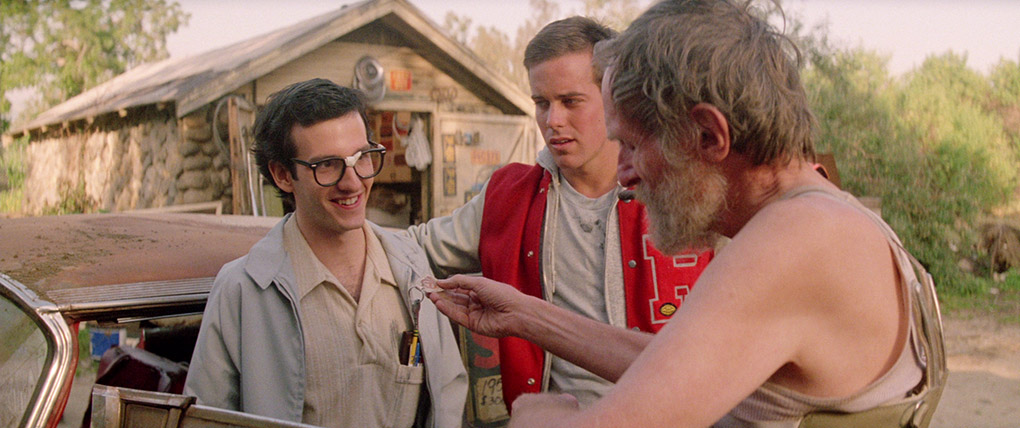
Early in the writing process Phillips and Carpenter made one crucial change to the novel and dispensed with the ghost of the car's previous owner, instead choosing to make the car inherently evil from its mechanical birth. We're clued in to this by a seductive prologue – set to the growling rhythm and blues of George Thorogood's Bad to the Bone – in which a production line worker is seriously injured and another killed by a bright red Plymouth Fury during the final stage of its assembly in 1957. 21 years later, bumbling and geeky Arnie Cunningham is riding back from school in the car of his childhood friend Dennis when he spots the resting hulk of the very same car in the yard of the ageing eccentric George LeBay, who reveals that the vehicle belonged to his late brother and that its name is Christine. For Arnie it really is love at first sight, and in his eagerness to own the car he pays LeBay far more than it's worth, much to the dismay of his protective friend. When Arnie's parents refuse to let him keep the car at their house, he rents garage space from grumpy scrapyard owner Will Darnell and begins the long process of restoring Christine to her former glory, a hobby that grows into an all-consuming passion and triggers significant changes in Arnie's personality and appearance.
Tales of worms that turn are almost as old as cinema itself and have a very real appeal, particularly for those of us who suffered at the bullying hands of others in our younger days. The trick here is that when the sympathetic and mercilessly put-upon Arnie finds the self-confidence that we can presume has been gifted to him by Christine, he is transformed into a self-centred and obsessive douche of the first order, and it's his nice-guy jock pal Dennis who steps up to the plate as the film's likely hero. But even at his most disturbed, Arnie is always interesting and his metamorphosis oddly believable. So convincing is the bond that grows between him and Christine, meanwhile (one that anyone who had a passion for anything in their teenage years – whether it be cars, sports or even movies – can surely relate to), that when beefed-up school bully Buddy Repperton and his tawdry entourage trash the car, it genuinely hurts and stokes in the audience a thirst for the revenge that we just know will soon follow.
The choice of car is crucial here and can't help but give the story a specifically American slant, as Christine needs to have the visual glitz and raw power of an American classic to give her the character required to bring her to life – all fiery red paint and polished chrome, she's the automotive equivalent of a self-confident and sexually alluring woman, kitted out in her best dress, her flirtiest lipstick and her shiniest jewellery. At her best she turns every head on the block, and every bump and scratch she takes prompts an involuntary wince. But get on her wrong side...
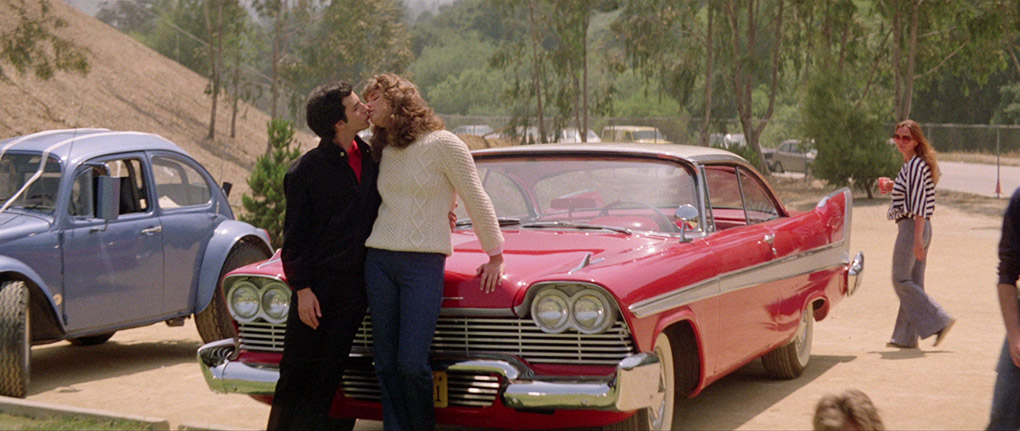
Despite discarding the ghost of Roland LeBay, Phillips and Carpenter still take their supernatural cues from their source material, some of which only really register in hindsight. Chief amongst these is the haphazard manner in which Arnie approaches the process of restoring Christine – there is a degree of logic to his actions, one driven by the order in which he might find replacement parts, but it still feels troublingly random, the result of a self-healing process over which he has no real control. The showpiece effects scene, in which Christine rebuilds herself after Repperton's attack, is a delicious example of how ingenuity, teamwork and practical effects can still trump CG. It's a sequence with deliberate and overt sexual overtones, but also provides a clear indication of just how difficult this particular movie monster will be to stop. Later, when the car barrels out of a burning garage with flames leaping from its bodywork, this previously sinister machine is transformed into a vehicular embodiment of the Angel of Death.
That the characters in a 110 minute movie lack the depth that they have in a 750+ page novel is par for the book-to-movie adaptation course, but this does tend to really hit home in film versions of genre works by Stephen King, whose protagonists and antagonists are often so vividly drawn and detailed and so uncannily true to life that you could almost swear you grew up with them, irrespective of locational or cultural differences. Character depth and backstory are both casualties here, as we're left to decide for ourselves why the friendship between these two starkly different individuals has lasted so long, and invited to observe rather than share the pain and confusion Dennis suffers as his old friend is changed beyond all previous recognition. Certainly John Stockwell makes for a likeable Dennis, and Alexandra Paul does a decent job as Arnie's surprise girlfriend Leigh, despite the decision to keep her and Dennis as friends within the timeline of the film instead of the lovers they become in the original novel, one presumably (and disappointingly) made with a judgemental mainstream audience response in mind.
Where Carpenter scores a bulls-eye is in the casting of offbeat actor and now successful director Keith Gordon as Arnie. Gordon absolutely nails the role here, having the angular features, haunted eyes, intensity and emotional range to utterly convince as both the bumbling nerd at the film's start and the cocksure monster into which he evolves. When he suddenly grabs his terrified father by the throat after an attempt to reprimand him for swearing at his mother (and there's a LOT of swearing here, apparently bumped up to secure the film the R rating its lack of explicit violence was otherwise likely to deny it), there's a very real sense that he could crush the man's windpipe without breaking a sweat. There's also some delicious cult casting in the supporting roles – Robert Prosky growls wonderfully as the grouchy Will Darnell, Roberts Blossom does a nice line in quietly menacing suggestion as George LeBay ("You don't know half as much as you think you do... shitter"), and you just can't go wrong with the always wonderful Harry Dean Stanton as investigating detective Rudolph Junkins.
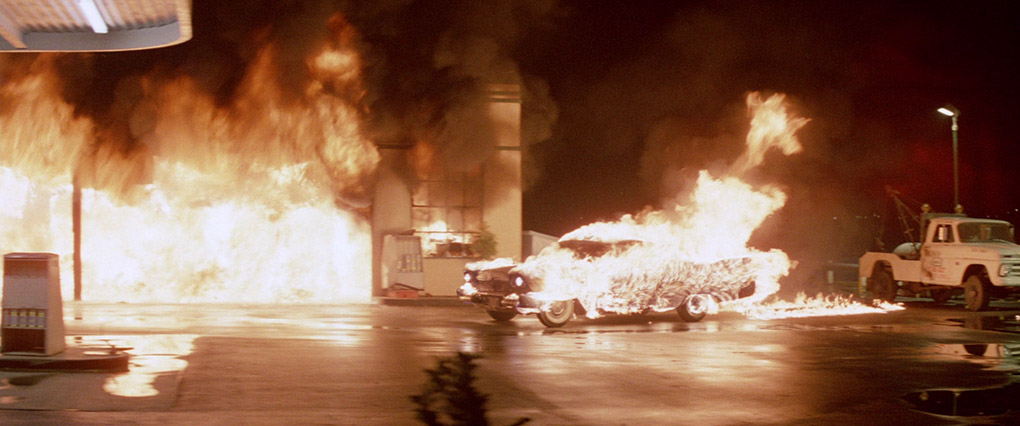
As an adaptation and as a supernaturally themed thriller, the film is at its strongest in its first half, when the precise nature of Christine's effect on Arnie is still uncertain and both he and his vehicle are undergoing the process of simultaneous transformation. The later action scenes are smartly staged (the gas station explosion is almost blockbuster in scale), but feel a little more generic, and while we're geared up to see Repperton and his gang get their just deserts, the bloodless killings that follow are not without their issues – one victim is crushed so slowly by Christine in a narrow loading dock that he could easily have climbed onto the hood and at least tried to make his escape (he probably wouldn't have got far, but still), and if you're being chased on foot by a flaming car, then running down the middle of an open road is probably not the best escape strategy. That the climactic battle between man and machine (and ultimately two machines) is not as tense is it should be is partly down to the nature of the monster in question – dangerous and threatening though automobiles can be, we see them every day and many of us own one, and thus they're just not as inherently scary as the relentless masked man with a butcher knife or the sword-wielding ghosts that made the climactic scenes of Carpenter's earlier Halloween and The Fog such nail-biters. That said, Freudians should have a ball with the machine-rape finale, a reading that Carpenter himself is most definitely aware of and probably intended.
Despite the dilution of the novel's characters and the fact that it's never as nerve-wracking as the director's top-flight thrillers, Christine still delivers as a horror-themed entertainment, and what worked for me back on its release still plays every bit as well today. The pacing is slick, Arnie's transformation is nicely handled (his increasingly retroactive wardrobe is a particularly neat touch), and the physical effects and stunt work are top-notch throughout. The score, by Carpenter in association with regular collaborator Alan Howarth, may lack the lodge-in-the-brain distinction of the themes from Halloween and Assault on Precinct 13, but is still effective in its blend of synth notes and industrial metallic percussion, and where others might invite critical flack by having sourced songs comment directly on the action, since they almost all emanate from Christine's radio, they play more like an expression of the car's mood and sardonic wit. It may not trigger the seat-grinding fear of Carpenter's most notable genre works, but Christine is still a solid and distinctive genre work that creatively compresses the essentials of the novel (it is, apart for a couple of significant alterations, a largely faithful distillation) and whose man-machine love story is just loaded with subtext and is frankly worth the price of admission alone. And yeah, the car looks great.
When the light levels are good, this 2.40:1 2k restoration by Sony really delivers the goods, displaying a strong level of detail, rock solid picture stability, a naturalistic if sometimes earthy colour palette and well balanced contrast. The image has less sparkle when the light levels drop, as the contrast feels harsher, with inky black levels but plenty of detail-free shadows; this many well be part of the film's chosen aesthetic, but still feels a little aggressive at times. Occasionally, as with Arnie's hospital visits to Dennis or some scenes set inside the Cunningham house at night, there's a glumness to the palette and intermittently a slight soft feel to individual shots (the result of a narrow depth of field, perhaps?), but the transfer still trounces previous DVD releases and Christine herself always looks terrific.
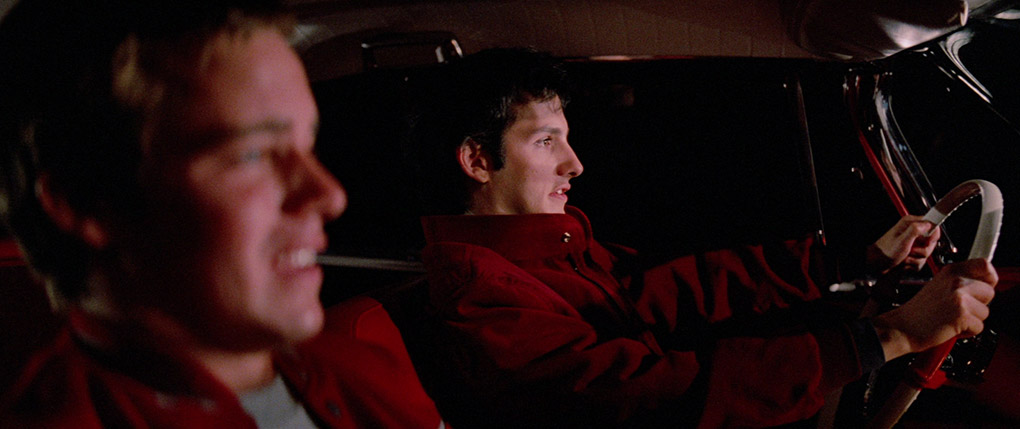
For the soundtrack you can choose between the original Linear PCM 2.0 stereo and a DTS-HD 5.1 surround remix. Both are in fine shape with a good dynamic range, excellent clarity and no signs of wear or age, but the 5.1 remix gives the whole thing a serious fuel injection, from which the music and sound effects really benefit. Play the opening credits in the original stereo and then in 5.1, and the throaty rumble of the Plymouth Fury engine ticking over and revving has a far more aggressive feel. Intermittently the ambient sound also gets a boost, notably the rainfall in the drive-in sequence, which here comes at you from every direction.
Optional English SDH subtitles are also on offer.
Deleted Scenes (26:02)
A sizeable collection of 20 deleted scenes, all edited but not scored and probably missing the sound effect here and there. Several are alternative takes or extensions of existing scenes, but there are still some interesting additions here, including confirmation that Dennis and Leigh become more than just friends when Arnie goes bad (this is sidestepped in the final cut) and an intriguing sequence in which Arnie's tearful mother watches her troubled son as he sleeps.
Christine Documentary (48:03)
Compiled for the 2003 Special Edition DVD release and divided into three chapters – Ignition, Fast and Furious and Finish Line – that can be watched individually or as a single piece, this is a comprehensive look back at the making of the film with contributions from director John Carpenter, producer Richard Kobritz, screenwriter Bill Phillips, stunt coordinator Terry Leonard, and actors Keith Gordon, John Stockwell and Alexandra Paul. It follows a linear path from conception to release and is packed with interesting stories and anecdotes, from the news that Kevin Bacon was scheduled to star until he landed the lead in Footloose to a gag played on Carpenter by Paul and her twin sister. Gordon looks back on this as the best film acting gig he ever had and a hell of a learning experience for a budding director, the multi-tasking Carpenter reflects on how many times his name appears on the poster and that it made him look like "an arrogant piece of shit," and Phillips pertinently reminds us that "a book is usually a 20 hour experience. A movie is usually about a 2 hour experience. Something's got to give. Something's got to be cut out." There's plenty more where this came from, all of it good. As a former DVD extra, the framing is 4:3, but visually it's in fine shape.
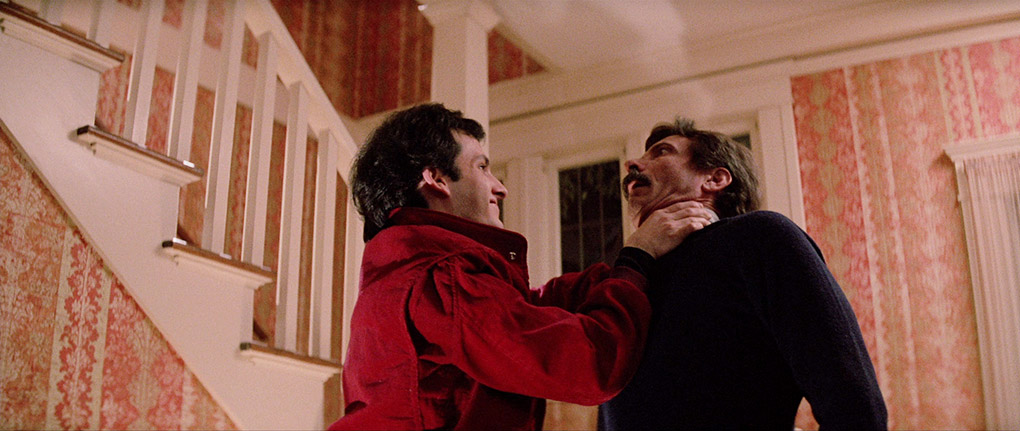
Audio Commentary
Also recorded for the Special Edition DVD release, this commentary by director John Carpenter and leading man Keith Gordon is a hugely enjoyable companion to the film. Carpenter always does good commentary, but really shines when he has a lively wing man (try Kurt Russell on The Thing or Roddy Piper on They Live), and Gordon is certainly that; he clearly enjoyed every minute of the shoot and treated it as a learning experience, and as a director himself knows enough about the filmmaking craft for the two men to bounce off each other wonderfully on a technical as well as anecdotal level. Lots of great stuff here and a few choice surprises, including an on-set visit from a budding young director named Sam Raimi, who had just completed a little film known as The Evil Dead. Both sing a hymn to the appeal of practical effects over CG, and Carpenter tellingly reveals that he never goes to the premieres of his movies, as when he does something really bad always happens. I so wanted him to elaborate on this.
Trailers & TV Spots has two of each and they are rather interesting. Trailer #1 (0:58) is a well edited piece that pushes the film as a horror story and uses King and Carpenter's names as key selling points. Trailer #2 (1:29) is a very different and altogether more intriguing sell, trading on the sexual appeal of the car and tracing the camera over its bodywork in a manner that tricks you into thinking that you're looking at the curves of a woman's body. "Body by Plymouth," the voice-over informs us, "Soul by Satan." Nice. The two TV Spots (0:32 and 0:34) are essentially cut-down versions of these same two trailers.
The Isolated Score is exactly what it claims to be, but interestingly (I smell copyright issues here) it only includes the music that Carpenter composed for the film and none of the sourced songs – even the George Thorogood track that leads us in to the film is silent here. Unlike a soundtrack CD, you'll have some rather long waits between relatively small snippets of music in the first half, but they do sound good when they arrive.
The Gallery consists of 30 production stills, a concept art image and a couple of posters, which can be manually advanced. All are in HD and a decent size.
Booklet
There's more than a whiff of Arrow and Masters of Cinema to the nicely produced booklet that accompanies this disc. It kicks off with an interesting essay on the film by Jeff Billington (one whose opinions I enjoyed but don't always share). This is followed by a genuinely fascinating piece by Carpenter himself from a 1996 issue of Film Comment titled John Carpenter's Guilty Pleasures, in which he discusses some of the unsung films – or "the slops and the trash" as he calls them – that befriended him in his youth, including The Giant Claw, The Green Berets and Beyond the Valley of the Dolls. Credits for the film, stills and a brief bit about the restoration are also included.
Definitely one of the stronger Stephen King adaptations, Christine is a compact and enjoyable distillation of a sizeable novel that unfolds intriguingly and benefits from Carpenter's eye for camera placement and pacing, as well as a compelling performance from Keith Gordon as Arnie, a choice supporting cast, some fine effects and stunt work and that damned car. A solid presentation is backed by some very decent extra features that you might know already but you wouldn't want to see this disc appear without. A good start for Powerhouse Films' new label Indicator.
|